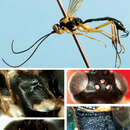Description
provided by Zookeys
Female. Body length about 7.2 mm. Fore wing length about 5.8 mm. Ovipositor sheath length about 1.7 mm.
Head.Face (Fig. 12) convex centrally, approximately 1.5 times as wide as long, with leathery texture and fine punctures, distance between punctures 0.3 to 1.5 times diameter of puncture; upper margin with weak median elongate tubercle. Clypeus smooth, median portion transversely convex, with sparse, fine punctures; apical margin weakly convex forward, with light brown hairs. Mandible relatively short and wide, with sparse, fine punctures, upper tooth slightly wider and longer than lower tooth. Cheek and gena with fine granular texture. Malar space approximately 0.5 times as long as basal width of mandible. Gena almost impunctate, slightly convergent posteriorly, in lateral view about 0.6 times as long as width of eye. Vertex (Fig. 13) with texture as that of gena, lateral portion between posterior ocellus and eye with fine punctures. Postero-ocellar line about 0.9 times as long as ocular-ocellar line. Upper and lateral portions of frons approximately flat, with distinct, dense, fine punctures; lower portion concave centrally, slightly rough, with dense, indistinct, fine punctures. Antenna relatively thin and long, with 32 flagellomeres, each segment longer than wide; ratio of length of flagellomere 1:2:3:4:5 is 6.3:4.7:4.3:4.2:3.8. Occipital carina complete and strong, joining hypostomal carina above base of mandible.
Mesosoma.With fine leathery texture. Lateral concave part of pronotum with weak, short transverse wrinkles; upper-posterior portion with weak, fine punctures, distance between punctures 0.5 to 2.0 times diameter of puncture. Mesoscutum evenly convex, with dense punctures, distance between punctures 0.2 to 1.0 times diameter of puncture; notauli very weak, vestigial on front portion of mesoscutum. Scutellum slightly convex, with very sparse, fine punctures; without lateral carina except lateroanterior corner. Postscutellum transverse, anterior portion concave, with short longitudinal wrinkles. Mesopleuron (Fig. 14) with even, fine punctures, distance between punctures 0.2 to 1.0 times diameter of puncture. Upper end of epicnemial carina almost reaching mid-height of front margin of mesopleuron, distant from front margin of mesopleuron. Speculum present, small. Mesopleural fovea deep. Metapleuron with texture as that of mesopleuron, but slightly coarser. Anterior portion of submetapleural carina convex, as a broad lobe, translucent. Wings hyaline. Fore wing vein 1cu-a distal of 1/M, distance between them about 0.4 times length of 1cu-a. Areolet obliquely quadrate, receiving vein 2m-cu approximately at apical 0.25. 2-Cu slightly longer than 2cu-a. Hind wing vein 1/cu about 3.0 times as long as cu-a. Legs comparatively gracile. Claws pectinate. Ratio of length of hind tarsomere 1:2:3:4:5 is 1.0:4.6:3.3:1.8:2.2. Length of hind claw approximately 1.7 times as long as largest width of hind tarsomere 5 in lateral view. Propodeum (Fig. 15) rough, with irregular short wrinkles. Posterior transverse carina complete and strong. Pleural carina and median portion of lateral longitudinal carina (betweenspiracle and posterior transverse carina) present. Petiolar area with flabelliform wrinkles. First and second lateral areas with indistinct punctures. Propodeal spiracle small, round.
Metasoma.Terga with dense punctures, but slightly finer than on mesosoma, posterior margins smooth. First tergum approximately 1.6 times as long as apical width, evenly narrowed towards base, with fine transverse lines. Median dorsal carina indistinct. Anterior portion of dorsolateral carina, before spiracle, strong; posterior portion weak. Spiracle convex, located slightly before middle of tergum. Secong and following terga with leathery texture and fine transverse lines. Second tergum approximately 0.9 times as long as apical width. Thyridium oblique, basal margin reaching basal margin of second tergum. Third tergum approximately 0.75 times as long as apical width. Ovipositor sheath approximately 0.7 times as long as hind tibia, 1.3 times as long as first tergum. Ovipositor strongly compressed, weakly upcurved.
Color.(Fig. 11). Black, except the following. Apical portion of flagella slightly blackish brown. Ventral side of scape, apical margin of pedicel, face (except upper margin irregularly black), clypeus, mandible except teeth, cheek, maxillary and labial palpi (except apical segments slightly filemot), lower portion of anterior margin, posterior margin and upper-posterior corner of pronotum, lateral margin widely and two narrow longitudinal median strips of mesoscutum, tegula, scutellum, posterior margin of postscutellum, a small spot on lower-anterior portion and irregular transverse band on lower-posterior portion of mesopleuron, lower portion of metapleuron, front legs, coxae, trochanters and femora of middle and hind legs yellowish white. Apical portion of middle tibia and tarsomeres yellowish brown to dark brown. Ventral and dorsal sides of hind tibia yellow, lateral sides dark brown. Hind tarsomeres dark brown, apical portions of each tarsomere yellowish brown. Stigma yellow. Veins brownish black.
- bibliographic citation
- Sheng M (2011) Five new species of the genus Cryptopimpla Taschenberg (Hymenoptera, Ichneumonidae) with a key to species known from China ZooKeys 117: 29–49
- author
- Mao-Ling Sheng

